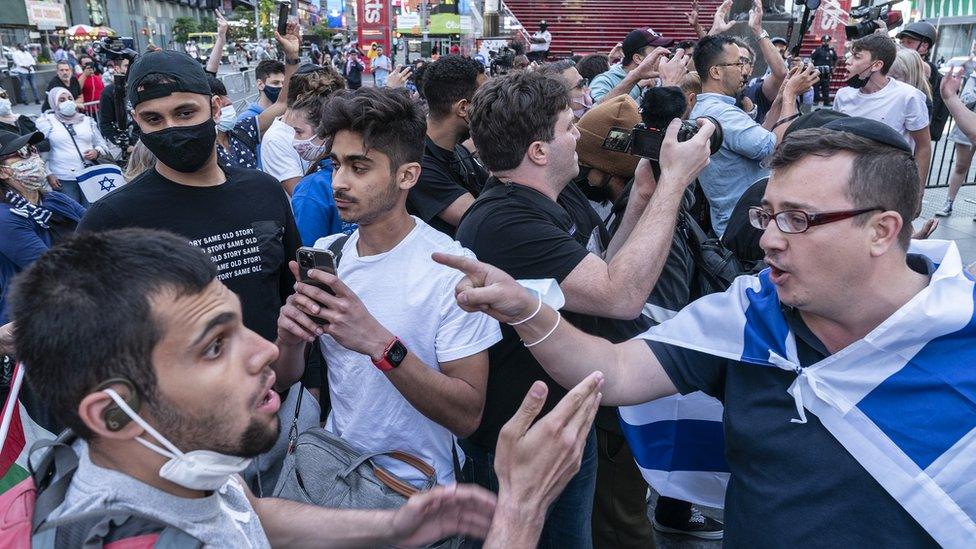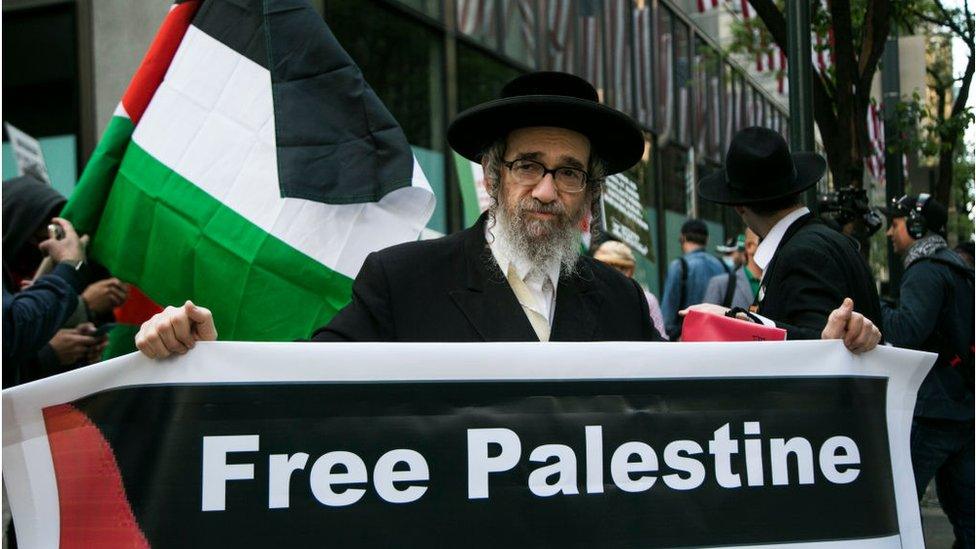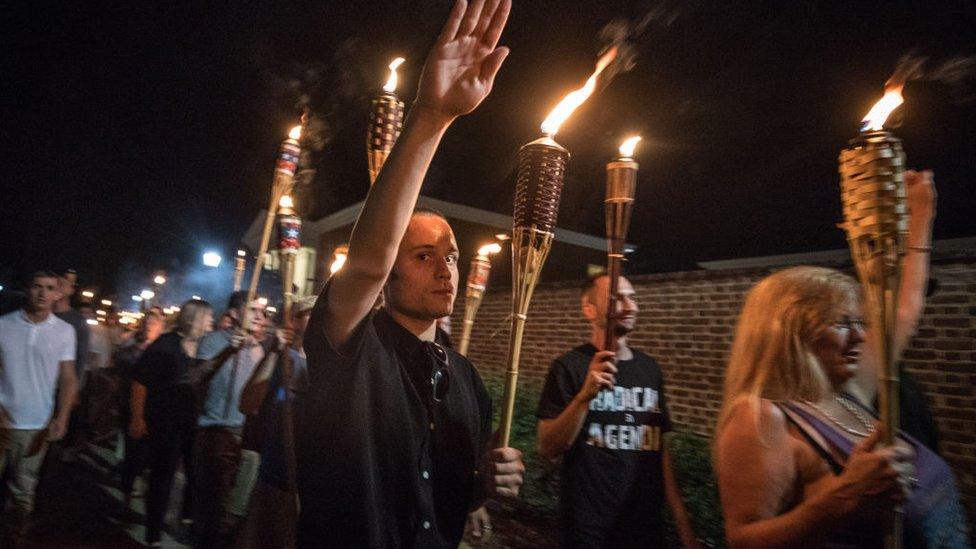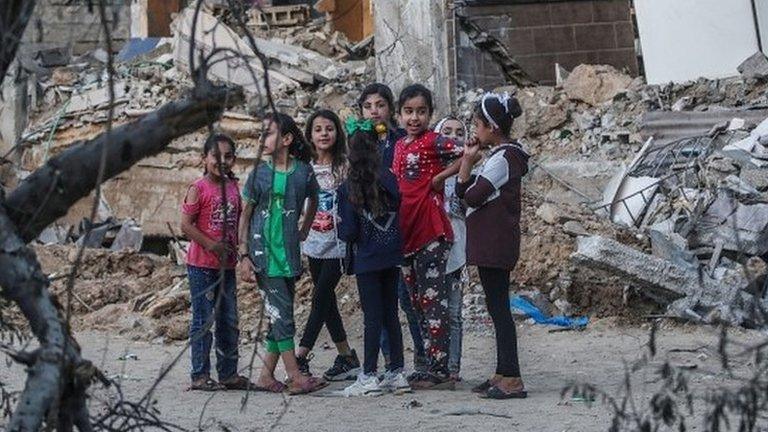Who's behind recent rise in US anti-Semitic attacks?
- Published

Clashes between pro-Israeli and pro-Palestinian groups erupted in Times Square earlier this month
As the world watched fighting rage in Israel and Gaza, US Jews endured an increase in anti-Semitic attacks on a scale not seen during previous Middle East conflicts.
Experts say it is too early to tell if the high-profile assaults - including a daylight brawl in New York City's Times Square - point to a trend, or are a part of already high levels of such incidents seen across the country in recent years.
Violence and harassment targeting American Jews broke out coast-to-coast amid the 11 days of fighting between Israelis and Palestinians that ended in a ceasefire on 20 May.
Incidents included outdoor diners in Los Angeles who were physically attacked by a group carrying Palestinian flags, violence against orthodox Jews in New York City - home to the largest population of Jews outside of Israel - and Nazi imagery posted on a synagogue in Alaska this week.
Pro-Palestinian protests and anti-Jewish vandalism at synagogues - which are quickly stepping up security due to the attacks - have also been documented in Illinois and Florida.
President Joe Biden wrote on Twitter on Monday: "The recent attacks on the Jewish community are despicable, and they must stop."

Orthodox Jews are especially vulnerable due to their distinctive attire
What do the latest figures show?
According to New York City police, there have been 80 anti-Semitic hate crime reports made this year, compared to 62 in the same period last year. They have stepped up patrols in Jewish communities, especially in orthodox Jewish neighbourhoods where the visibility of traditional Jewish clothing increases the likelihood of attack.
The Anti-Defamation League (ADL), which tracks incidents of anti-Jewish violence and bias, says they saw a 75% increase in anti-Semitism reports to the agency's 25 regional offices after Israeli-Palestinian fighting began.
The figure jumped from 127 incidents in the two weeks prior to fighting to 222 in the two weeks after violence broke out.
Oren Segal, vice-president of the ADL's Center on Extremism, says similar surges have occurred in previous Israeli-Palestinian conflicts.
"Usually it's not surprising to see a spike because of the invective and anger that comes with a conflict," he says.
"A lot more protests, a lot more grievances and at times that leads to a lot more expression of anti-Semitism and incidents of anti-Semitism."
In the US, Judaism is a religion whose adherents profess a diversity of political beliefs. Critics of Israel sometimes conflate Israel, the only Jewish nation in the world, with Judaism the religion.

One of New York's orthodox communities ardently support Palestinian rights
Social media has also played a major role in the spike, says Segal. The ADL has tracked increased references on Twitter to pro-Nazi hashtags since the fighting began.
Anti-Semitism in the US went up only "very, very little" during other wars in Israel's history - in 1967, in 1973 and during Palestinian uprisings in the 1990s and 2000s, says Yehudah Mirsky, a professor at Brandeis University who studies modern Jewish history.
"We've seen things like this before," says Mirksy. "It's all too early to crunch the numbers. But this seems a bit much. This seems more."
He adds that the conflict is sometimes used by US activists from across the political spectrum to "manufacture social division", from corners as diverse as far right ex-Trump adviser Steve Bannon and by antifa, the loosely knit group of far-left activists.
"In many respects a national struggle - between two national groups - gets transposed into the American framework of seeing it as a civil rights struggle," he says of the conflict.
"In recent years with people tossing around terms like 'apartheid' and 'ethnic cleansing', those terms kind of take Israel out of the realm of politics and into pure moral struggle."
Mirsky says the moral battle distracts from the reality that the conflict is "an incredibly complicated political situation".
"And it just becomes this stark black and white morality tale for which the bad guys can have no justification at all - and the bad guys become the Israelis and the people who support them."
Two children from Gaza City and Israel describe their experience of the Israel-Gaza conflict
What's fuelling the general rise in anti-Semitism?
An annual report released by the ADL, external in April found that 2,024 anti-Semitic incidents were reported in 2020, dropping 4% from an all-time high in 2019.
Last year saw the third-highest number of reports of assault, harassment and vandalism toward American Jews since the ADL first began tracking the data in 1979.
Experts say the recent attacks are being driven more from the political left than ever before. It comes as pro-Palestinian supporters blame American Jews for Israeli government policies.
"For four years it seemed to be stimulated from the political right, with devastating consequences," the ADL's Jonathan Greenblatt told the New York Times, external.
But in the most recent attacks "no one is wearing Maga hats", he added, referring to the Make America Great Again Hats worn by Trump supporters.
Much anti-Semitism in the US still comes from the far-right, including the gunman who killed 11 people at a synagogue in Pittsburgh in 2018.

At a 2017 rally in Charlottesville, far-right activists chanted "Jews will not replace us"
But the ADL's Oren Segal says it's not important which side of the political aisle is instigating the anti-Jewish movement.
"Anti-Semitism is not a right-wing issue. It's not a left-wing issue. It's a problem in and of itself. It's unique, in that no matter where someone is on the ideological spectrum, they're able to manipulate anti-Semitic tropes to make a point if they want to.
"Sometimes it's not necessarily coming from an extreme left or an extreme right, but it's just an anti-Semite."
He says public figures such as Georgia congresswoman Marjorie Taylor Greene, who has likened coronavirus masking measures to the Holocaust, which killed six million Jews, have played a major role in the general rise in anti-Semitism in the US.
"Any public official, whether left or right, who is normalising tropes commonly used by anti-Semites, that's a problem," he adds.
"Normalising anti-Semitism, I think, has more to do with the rise in anti-Semitism than people might think."
Related topics
- Published27 May 2021

- Published26 May 2021
